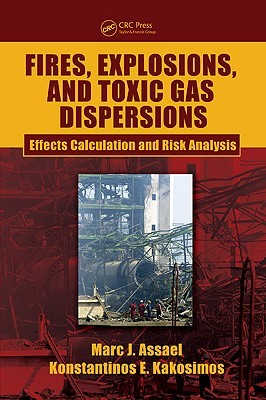
- We will send in 10–14 business days.
- Author: Marc J Assael
- Publisher: CRC Press
- ISBN-10: 1439826757
- ISBN-13: 9781439826751
- Format: 18 x 25.4 x 2.3 cm, hardcover
- Language: English
- SAVE -10% with code: EXTRA
Reviews
Description
Today's risk analysis is a very challenging field, and a solid understanding of the calculations procedure associated with it is essential for anyone involved. Fires, Explosions, and Toxic Gas Dispersions: Effects Calculation and Risk Analysis provides an overview of the methods used to assess the risk of fires, explosions, and toxic gas dispersion, and then deduce the subsequent effects and consequences of these events.
The authors cover various aspects of such incidents, including the probability that an accident will occur, and how to calculate leaks, heat flux, overpressure, and the concentration of toxic clouds. The book follows by describing the consequences to people (injury or death) and material damages, and it concludes with a discussion of possible causes of destruction and common circumstances that can result in accidents.
Some key features of this book include:
- Introduction of basic techniques of hazard identification, emphasizing "what if" and HAZOP analyses
- Step-by-step procedures for the calculation of fires (i.e., pool fire, jet fire, fire ball), explosions (VCE, BLEVE), and concentration of toxic clouds (light and heavy gases)
- Methods for determining probability of injuries or lethality
Invaluable to professionals, researchers, and students whose work involves predicting the consequences of accidents, this book describes simple modern methods, which are a great aid for understanding the meaning of all the variables involved-in contrast to current complicated computer packages, which produce only results. Filling the existing gap in useful literature on risk analysis, this book follows a logical structure and presents straightforward, step-by-step calculation procedures and numerous examples that will be valuable in both teaching and learning the content.
EXTRA 10 % discount with code: EXTRA
The promotion ends in 20d.06:16:37
The discount code is valid when purchasing from 10 €. Discounts do not stack.
- Author: Marc J Assael
- Publisher: CRC Press
- ISBN-10: 1439826757
- ISBN-13: 9781439826751
- Format: 18 x 25.4 x 2.3 cm, hardcover
- Language: English English
Today's risk analysis is a very challenging field, and a solid understanding of the calculations procedure associated with it is essential for anyone involved. Fires, Explosions, and Toxic Gas Dispersions: Effects Calculation and Risk Analysis provides an overview of the methods used to assess the risk of fires, explosions, and toxic gas dispersion, and then deduce the subsequent effects and consequences of these events.
The authors cover various aspects of such incidents, including the probability that an accident will occur, and how to calculate leaks, heat flux, overpressure, and the concentration of toxic clouds. The book follows by describing the consequences to people (injury or death) and material damages, and it concludes with a discussion of possible causes of destruction and common circumstances that can result in accidents.
Some key features of this book include:
- Introduction of basic techniques of hazard identification, emphasizing "what if" and HAZOP analyses
- Step-by-step procedures for the calculation of fires (i.e., pool fire, jet fire, fire ball), explosions (VCE, BLEVE), and concentration of toxic clouds (light and heavy gases)
- Methods for determining probability of injuries or lethality
Invaluable to professionals, researchers, and students whose work involves predicting the consequences of accidents, this book describes simple modern methods, which are a great aid for understanding the meaning of all the variables involved-in contrast to current complicated computer packages, which produce only results. Filling the existing gap in useful literature on risk analysis, this book follows a logical structure and presents straightforward, step-by-step calculation procedures and numerous examples that will be valuable in both teaching and learning the content.


Reviews